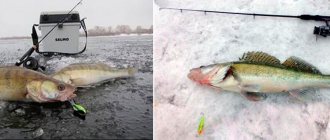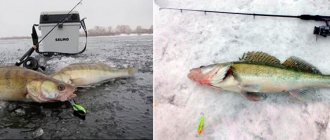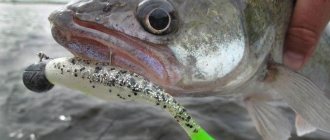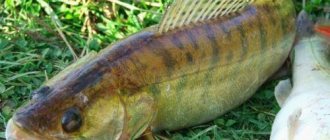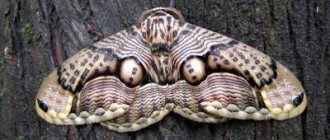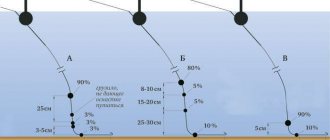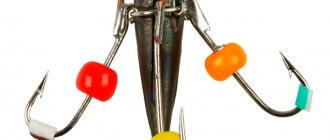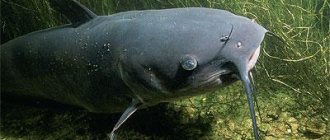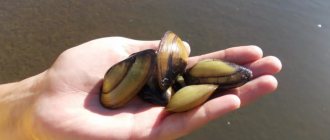Recreational squid fishing
Amateur squid fishing in our country is possible only in the Far East; for other Russian fishermen it is truly exotic.
As a rule, commercially caught squid have an average size of 0.25-0.50 mm. But there are also giant squids that live at great depths, up to 8000 meters and have gigantic sizes of about 20 meters long, including tentacles. They are considered the largest invertebrates on the planet. These mollusks live almost everywhere in the world's oceans, including the Arctic zone. However, the largest populations of squid are found in subtropical and temperate waters. The variety of squids that live in the northern seas are much smaller in size than those that live in warmer waters and lack bright colors.
The first large schools of squid appear in Primorye in mid-June, then they appear off the coast of Sakhalin, around the beginning of July. In the Strait of Tartary, schools of squid appear in early August.
Recreational squid fishing is not particularly difficult. To catch squid, amateur fishermen use rather primitive baits. In Primorye, during the Soviet era, squid were caught on simple shiny stainless steel “spoons” using a bamboo rod equipped with a regular Nevskoy-type reel.
Simply put, the most effective way is to fish with a jig. The gear used to catch squid is called a spinning jig, which is also the name for the method of catching this mollusk at night. To catch squid, the technique of uneven wiring is usually used, and a special “squid fish” is used as bait.
The peculiarity of this bait is that in its middle or end part there are very sharp sharpened needles, with the help of which the tentacles of the mollusk are hooked and fixed during fishing in the open sea.
Fishing for squid using a spinning jig has certain features in the equipment. To catch a shellfish, you need a spinning reel and bait, a rod, line and reel are the same as for fishing for regular fish, and the peculiarity of squid fishing is, first of all, the ability to give the bait a special character of movement.
Today in the world when catching squid, modified wobblers with a special rim for hooking and subsequent fixation of the tentacles are widely used. In addition, the most important attribute for night fishing for squid is a luminous device with a built-in LED, it is installed in the upper part of the installation and it is a bait for squid.
Squid mainly hunts at night; the best catches occur in the dark, and if you successfully catch a school, then in 2-3 hours you can catch a huge variety of mollusks, especially if there is a full moon. The most optimal depth at which fattening squid usually stays is 10-15 m. The main thing when fishing for squid is to find a bank on which it stands and catches small fish.
Amateur squid fishing at night with the help of a flashlight and squid baits is carried out in a variant where the equipment with a sinker is thrown at 25-30 meters and within 1-2 minutes is lowered completely to depth, then a sharp reeling is carried out at maximum speed. Most often, the squid takes it either on the descent into the depths or near the bottom, and during a sharp rise to the surface.
The greatest importance for fishing in the Far East is the Pacific squid, which comes here in the summer season. On average, catches are dominated by individuals from 28 to 50 cm in length. But this type of squid can reach a length of 80 cm, taking into account the length of the tentacles. This cephalopod feeds on small fish and large zooplankton, and becomes sexually mature at the age of 1 year. It is also believed that almost all squid belonging to this species die after spawning.
Catching commander squid also makes up a fairly large percentage of our fishermen’s catches. It is this one that is mainly sold on store shelves and is the cheapest of all squids. Its maximum length is 45 cm, and its weight is 2.5 kg. The squid reaches sexual maturity when its total length reaches 25 cm. The life expectancy of the Commander squid is 2 years. On average, the catches include individuals weighing from 300 grams to a kilogram and 25-35 cm long. They mainly prefer depths from 15 to 30 meters.
Recreational squid fishing is very interesting both at night and during the day. With good skill and experience, you can catch up to 30 kg of this mollusk in 1 night.
| There are many types of gear for squid fishing, Korean, Japanese, Chinese, which differ from each other only in small details. Of course, in terms of fishing line, other equipment does not compare with the Japanese one. However, the choice and preference is up to the fishermen themselves. But squid are caught not only at night; in the daytime, these mollusks are as active as at night, but they are not easy to detect in unfamiliar areas of the sea. The most profitable option is if you go squid fishing to time-tested places where squid constantly hunt, especially if this area is a commercial squid fishing area. In this case, during the day it is quite possible to use either a loaded squid for fishing at depth, or without a load for catching cephalopods at the surface of the sea. Quite often, fishing for squid near the surface does not require much effort. A short and smooth pull of the spinning rod, which is formed due to the rocking of the vessel on the wave, helps to quickly and accurately hook the squid. In this situation, the most effective is to slowly pull the bait down and up. Also, in the installation for fishing during the day, a flashlight is not required and in its place an additional squid can be attached to the leash, which increases the efficiency of catching squid. Today, about 250 species of squid live in the world's oceans, among which there are both giants and very small species. The largest species is the Atlantic squid "Architheuthis". The length of its mantle is more than 6 meters and the full size with tentacles can reach 23 meters with a total mass of more than 50 kg, the smallest is the glowing squid, about 15 cm long, and weighing 65 g. In the waters of the Far East, the most common are 3 types of squid. Commander squid - has a length of 27 cm and weighs about 0.7 kg, Pacific squid is up to 33 cm long and weighs up to 1 kg, baratram is 35 cm long and weighs over 1 kg. Some species come here to feed in the summer and fatten until autumn, while other species live permanently in the Far Eastern waters. |
General information about bait
Squids are cephalopods ranging in size from 0.25 to 0.5 m. Some reach large sizes (giant squids). Their sizes depend on the depth of their habitat. Giant representatives can live up to 18 years. It has a torpedo-carrying body that allows it to move quickly and has absolutely no bones!
You can read more about the biology of the mollusk at https://ru.wikipedia.org/wiki/Squid
Cuttlefish.
Cuttlefish caught in Ashdod
This mollusk got its interesting name from the Greek words “head” and “legs”. In the waters it is found in various sizes from 2.4 cm to 90 cm. With its beak-shaped and sharp proboscis, the cuttlefish easily cuts any prey. Her body produces a specific substance (sepia), which she uses as a last resort for protection.
The main defense is the ability to change colors and adapt to environmental conditions. The common cuttlefish has a size of 20 to 30 cm. Cuttlefish live for about 2 years. They have two “secret” tentacles, which are revealed when taking prey.
Read more about cuttlefish at https://ru.wikipedia.org/wiki/Cuttlefish
1.1 Bait habitats
The cuttlefish is a bottom dweller who spends all its time in shelter, lying in wait for prey.
Squids live at depths of up to 500 m. Larger individuals live in deeper water areas. Most small-sized mollusks live at a depth of 00 meters. In summer, mollusks rise to the surface.
1.2 What do squids eat?
Squids feed on small fish, worms or crustaceans (shrimp), plankton, and algae.
Cuttlefish are not picky eaters; they eat anything that moves, including smaller mollusks, shrimp and crustaceans.
1.3 When can you catch bait at sea?
The squid fishing season is the cold season, less successful fishing in spring and autumn. In the summer, these sea inhabitants go far from the coast in search of cool places. Cuttlefish can be caught well at water temperatures up to 26 degrees.
Fishing methods
Where to fish? Of course, as always and everywhere, relief is “our everything.” Ports, embankments, stones, groins and accompanying structures at the bottom are what you need. This could be a ridge extending into the sea, the edge of a port dump, or a transverse groin near the beach. All places where there are at least some quiet spots, shelters and changes in terrain. It’s even better if the relief is combined with underwater vegetation.
If, based on the totality of all parameters, the place looks like a worthwhile one, then the next (also similar to freshwater fishing) correct reference to the point is the presence of fry in shallow water. If there is a fry, then there is a shrimp, and someone will definitely come closer to sunset for such an Olivier. Well, the apotheosis of a good point will be the presence of local fishermen nearby. Or traces of their presence (gear packages, pieces of fishing line, etc.).
Important point. Everything seems to be fine, warm and all that. But it’s one thing during the day - you climb up to your waist, jump from rock to rock and stand in the warm water, splashed by a wave - it’s even refreshing. It’s a different matter at night - everything is much darker. Even though the waves are not ocean waves, and the tide is not two meters high, the stones are still sharp and slippery, and an event in the dark turns into a dangerous one.
It’s better not to go on such fishing alone. The range of ebb and flow here is childish - about 10 cm, probably. But he is. Some of the stones that are always under water are extremely slippery. The part that is periodically above the water is sharp and rough. During the day everything is visible and clear, at night you slip and slide every now and then. The water is ankle-deep, but if you slip one foot into a meter-long crevice, and your head hits a pebble, a wave will cover you - and hello... But breaking or dislocating a leg is generally a piece of cake. So you need to walk together and always be in sight.
It also happens: How burbot bites in the fall
Equipment
Flashlights (headlamps, handhelds, or cell phones) are required. During the day everything is visible, but at night... I left the underwater rock for half an hour in the sea, and the sun set. I turned around... how to get out? 5-10 meters to dry stones, and everything else is under water. Even a cell phone flashlight will do a good job. Shoes - “coral shoes” or “crocs”.
The former slip less, the latter hold the foot better. In general, if you have waders, it’s better to wear them. You won’t freeze, but if you stand knee-deep in salt water for a long time, then your feet will become very dry and flaky. No waders - a rich cream will help. Isn't he there too? Any will do. At least for sunburn. It will still protect the instep, shin and calf from “salting” for some time. You also need to take something warm. It's still cool in the evening. Standing for hours in the water (even though it is 28) and in the breeze, you can get hypothermic in the excitement.
Squid and cuttlefish are ten-armed cephalopods. They have five pairs of tentacles, one of which has been transformed into the so-called hunting tentacles. They are longer and stronger than others and are designed to “shoot” the prey and pull it towards the other eight, which will hold it and send it into the beak. Squid and cuttlefish live in different niches.
But they are often found near the shore and intersect with these niches. There is also their third close relative - the octopus, which also often “grazes” nearby. This one occupies the lowest bottom tier and even the “basement”, living near and under stones. The octopus is very slow, tied to the bottom, not a spinning character.
But the cuttlefish occupying a higher tier (the bottom and near it) is already quite ready to “run” after the bait. The squid is not attached to the bottom at all; its element is open water. These two are pronounced hunters, ready to pursue their prey (and therefore bait) - and gave rise to the creation of a whole direction in spinning rods - EGI.
The coastal zone does not shine with trophy size. The cephalopod that can be caught offshore is the common squid. So you shouldn’t hope to catch the giant Architeuthis, 16.5 m long. The average size of a coastal kraken is 25-30-40 cm. At least near populated areas and in tourist areas, which, as a rule, are adjacent to calm waters and places with shallow depths, there will definitely be no monsters.
Basics
The essence is simple beyond belief. Small fish and shrimp, calmly escaping predators in the light of day, become easy prey closer to dusk and at night. Nature has endowed cephalopods with such huge eyes that the reflected light of the stars is enough for them to hunt. Not endowed with the speed of tarpon or barracuda, they take advantage of this advantage when they go hunting in the evening.
At night it is much easier to get within shooting distance of a fry or shrimp. The rest of the time, chromatophores help them hide themselves, giving cephalopods the ability to instantly change color in changing conditions. So at night in and near shallow water they are the main hosts. About the same as our pike perch on the rifts.
It is better to arrive at the chosen place in advance. At least an hour and a half before sunset. Firstly, no one is safe from the release of seabass or barracuda during daylight hours. It makes sense to warm up and leave the bait suitable for this fish. Secondly, on good days, the cephalopod predator begins its hunt long before sunset.
It can also be caught during the day (as a rule, on the farthest and deepest lines). And I saw the first visible attack of the squid an hour before sunset, a couple of meters from my feet. While looking at the bait, I noticed how a squid appeared “out of nowhere” and attached itself to the tail of my jig shrimp, then in a split second changed color from blue to red-brown, caught up and, throwing out attacking tentacles, pulled it towards itself, immediately wrapping it around the rest.
Seeing the attack is very useful. This makes it much clearer what is happening there, in the distance, at the discharge in complete darkness. Hands remember the algorithm of actions perfectly. So, an hour before sunset you need to be in place and you can safely count on a bite. After sunset, depending on the conditions, you can fish for a couple more hours. And then it’s smarter - already a couple of hours before dawn.
Lures
Squid-jig is a sinking, front-loaded shrimp imitation, equipped with a tuft of beardless singles in the tail. A squid can also land on a regular wobbler tee, but the bite rate will be 1 in 100. And if it does, the hook will tear the delicate tentacle and the squid will get away. So a “bundle” of hooks is the only option that securely holds the predator.
These baits are graded according to the speed of immersion. Usually it is reflected on the packaging in the numbers 3-7-9, etc. This is nothing more than the number of seconds during which the bait sinks 1 m. That is, the lower the number, the heavier the squid-jig. It should be noted that almost all of them are “slow” in the spinning sense.
This is unusual. Well, how? do you think the shrimp should move? Short jumps in the water column. This is how the bait moves. By “freshwater” standards, coastal wiring can perhaps be called soft twitching with stop{amp}amp;go elements. Deep retrieving (when fishing on a throw) is called pumping.
Its essence is also simple: drowning the bait to the bottom. With several short strokes of the rod, it is lifted from the bottom, forcing it to jump upward with jerks, then a pause follows. This results in a sharp twitching in the first phase and a jigging pause in the second phase of the retrieve. The first phase attracts from afar, the second motivates to bite.
Does everything sound vague? Nonsense! Squid jigging is exactly the case when it takes longer to explain than to learn. How would you, for example, check a reservoir for the presence of active fish with a wobbler? First, comb it sharply. Then slowly. Install the Slow Slow Sinking or Suspender version. It's about the same in meaning and tempo, only the jerks are generally softer.
Based on the accumulation of fry and the relief, the easiest way is to systematically penetrate the entire accessible adjacent sector with fan casts. To begin with, put a heavier “shrimp” and fish at a fast pace. There is an active cephalopod - it will immediately bite. Then catch more slowly, taking into account the sleepy ten-armed predator.
Same with the horizon. First we break through the upper horizon, then lower. All the way to the bottom. Waves do not interfere with the work of the bait. You don't need to pay attention to them. The bait always works. Even when she turned sideways and staggered in the surf near the stone. It is only important to clearly understand where the squid-jig is located and control the “braid”.
It also happens: The weight of the pike when fishing
Nuances
A bite near the shore, then at 10 m, then at 15 m a couple more bites. Pack. If you get caught in a school of squid, don’t hesitate. They move quite quickly. The direction of movement, as a rule, is calculated very quickly from new touches and strikes on the bait. Here you need to have time to get ahead of the curve and carry it out a little slower and with long pauses.
If all the bites are in approximately the same place and are not hooked at all, it means that the squid has sank to depth, but has not left. Naturally, it is worth lowering the wiring horizon and increasing the number and duration of pauses. Everything is actually very similar to catching a school of pike perch or perch. The approach to cuttlefish is more similar to that of pike.
Lures for catching squid
For many, amateur squid fishing is considered something out of the ordinary, exotic, or seems like some kind of difficult activity. From a complicated point, however, it can be noted that squid is caught in our country only in the Far East. For many fishermen in the country it is simply difficult, and sometimes impossible, to get to their fishing spots. And despite this, I want to tell you about the bait for catching squid and about catching squid from a boat at night.
In the Far East of our country, amateur fishermen began to catch squid using ordinary bamboo rods and reels, which could be obtained in Union stores. The bait was an ordinary homemade spoon spoon made of stainless steel. This alone should give you hope that catching a squid is not difficult.
We caught squid both from the shore, pier, and from vessels of any complexity. Of course, fishing for squid from a vessel is preferable, but fishermen who know the coastal fishing spots rarely leave empty-handed.
From mid-June, the first large schools of squid approach Primorye, which of course does not impose a limitation on what you can try to catch earlier. Catching squid earlier imposes one limitation - the chances of catching will be less. Therefore, it is better to choose the time from mid-June to the end of July.
The ideal time to catch squid is at night. It is advisable to have and use an echo sounder on the ship - the chance of getting into a large school and catching a large number of squid in 2-3 hours increases. Although this is not sporting, if you take into account that you are at sea and not on a lake, this issue can be closed.
The boat must have a spotlight or “chandelier” - a garland of powerful lamps. The squid will be attracted to light, but the school will stand on the edge of light and darkness, both in the horizon and in depth. Casting the bait should be done at a distance of 20-30 meters from the vessel.
It is advisable to use a special spinning rod for jerking, with a dough of 15-25 grams. Although no one is saying that the usual spinning rod in your collection cannot work when catching squid. But if there is an opportunity, as they say, it is better to use it. The reel is light, inertia-free, 2500. Fishing line or braid should be taken with a tensile strength of 10-15 pounds and not skimped. You can save on wobblers, although this is everyone’s business.
The main bait for catching squid is a modified wobbler similar to a shrimp. The so-called Egi (egi) or in our language “squidfish”. It is distinguished by a peculiar bend and the presence of special hooks at the tip. Such wobblers have negative buoyancy.
You can also use a regular “squid bowl” in the form of a barrel with lighting inside. As a rule, this is a regular, not bright LED. It, like the “shrimp”, has negative buoyancy and a pair of hooks.
Nowadays, many manufacturers make wobblers for squid - from famous Japanese (for example, Yo-Zuri Squid) to manufacturers from the Middle Kingdom at ridiculous prices.
The squid can be caught by twitching or regular even wiring. The use of a special spinning rod is associated with this, as well as with the specifics of fishing for squid. Having thrown the bait behind the light spot, you should wait until it touches the bottom. It should be noted that when hunting for fish, squid rarely stays at the same depth. In connection with this, the “squid fish” should be lowered to the bottom.
Experimenting with wiring and coloring of a wobbler is never superfluous. If you try a light twitch and get no results, you can use regular uniform high-speed wiring. The same applies to the wobbler - it often happens that out of the entire stock of baits, the cephalopod likes only one color, but this color will provide you with a constant and not small squid catch.
The squid, if tempted by your bait, clings to the hooks with its tentacles. I will note three important points that you should not forget about when you get a bite.
- After making the hook, you should reel in the fishing line (braid) evenly and continuously. If you stop, the squid will have a huge chance of disentangling its tentacles from the hook.
- If you hook a squid that weighs half a kilo, you will drag it as much as 2-3 kg. This is due to the fact that the squid, resisting, gains water and thus creates a sail effect.
- If suddenly you feel that it is going very tightly or not at all, the clutch is cracking - most likely you will have to say goodbye to the wobbler. You hooked an octopus or cuttlefish.
In the afterword of my article, I want to wish all amateurs and professionals in fishing to fulfill their wishes. And I will be pleased if, after reading this article, one of your desires becomes squid fishing. I will say in the words of one of the Russian monopolists - “Dreams come true.”
In the past, and even today, residents of Primorye caught and catch squid using ordinary spoons. To do this, use traditional vertical baits, such as jigs. In recent years, most amateur fishermen, including European ones, have given preference to specialized baits, designed specifically for this kind of fishing.
They are made in various versions in many Asian countries: Korea, Japan, China and others. An important nuance when choosing baits and equipment is the ability of squid to change color under the influence of electrical discharges. Fishing methods and bait using luminous elements are based on this.
Useful links about squid and cuttlefish
https://forum.israfish.com/viewtopic.php?t=8776 - information about squid as bait on one of the most popular fishing sites in Israel https://ribalka-zima.ru/o-nazhivke/kalmary - tips for cleaning squid as bait https://yci.co.il/services/lovlya-kalmarov-i-karakatic/ - features of fishing for squid and cuttlefish in Israel https://dfdrussia.wordpress.com/2016/12/29/ interesting-facts-about-cuttlefish/ - many interesting facts about cuttlefish https://foodinformer.ru/hranenie/moreprodukti-hranenie/kak-i-gde-pravilno-hranit-kalmary - detailed information on how and where to store shellfish
Fishing places and habitat
Squids live in most climate zones, but are most common in subtropical and temperate regions. Some northern species are smaller in size and, as a rule, do not differ in color variety. There are no squids, like other cephalopods, in the Black Sea, which is due to the low salinity of the water.
In Russian waters, the most famous squid are those living in the waters of the Pacific region. Here you can catch shellfish even in the summer waters of the Sea of Okhotsk. In Primorye, schools of squid appear at the end of July. In addition, squids live in most of the seas surrounding Europe, from the North to the Adriatic. Squid fishing in the Mediterranean Sea is very popular and is practiced on fishing tours.
It also happens: Fishing with wobblers for beginners
Where and when to catch squid
In our country, the Pacific Ocean region is a promising region for catching cephalopods. Fishing in the Far East, on the shores of the Okhotsk and Bering Seas, and in Primorye on the coast of the Sea of Japan, is famous for its constant and stable catches. In the waters of the Pacific Ocean washing the territory of Russia, squid can be found throughout the year, including during the popular summer holiday period.
The mollusk has adapted to the conditions of temperate and subtropical zones of both hemispheres of the planet. It can be found in all the seas washing Europe. Fishermen hunt for squid from the North Sea to the Adriatic. Specialized squid fishing tours to the Mediterranean Sea are especially popular. Countries such as South Korea, Japan and China can boast of an organized hunt among amateur fishermen for the delicacy of this mollusk, where squid fishing is actively done in coastal waters and where the culture of fishing for cephalopods, which is an important component of local cuisine, is very widespread.
Industrial squid fishing is carried out in the South Atlantic in the region off the coast of South America. In the Northern part of the Pacific region, the mollusk is caught off the Commander Islands, the coast of Canada and Alaska. Schools of squid live in salty waters, avoiding desalinated waters and places where large rivers flow into the sea. In particular, the Black and Azov Seas are not inhabited by any species of cephalopod. These inland marine areas are not salty enough in composition for squid to thrive. The animal is prone to changing color, and the warmer latitudes a mollusk species lives in, the more intense and varied its color. It has also been noted that the size of squid in water with high temperatures increases much faster than those species that live in cold waters in northern latitudes.
You can catch squid throughout the year. It becomes more active in winter and summer. Many species of cephalopods (one of them is popular for fishing among our domestic fishermen - the commander) spawn twice a year - in the spring and autumn. At this time, the squid's bite is not stable, or even completely absent. If they are caught, they are small and immature individuals. Therefore, focusing on the season, preference is given to the winter and summer periods, when the activity of the fished object is high, and large and selected specimens are caught.
Catching squid and preparing for it
Squid fishing in the Far East has always attracted many amateur fishermen. During the Soviet Union, these cephalopods were mainly caught using bamboo rods equipped with the legendary “Nevskaya” reel. However, in our time, when fishing stores have a huge selection of a wide variety of tackle and bait, even an inexperienced fisherman who does not have the necessary skills can count on catching a dozen fish per night.
So, what gear do you need to catch squid? First of all, these are jig tackles. That is, to catch squid you need a spinning jig; this simultaneously means both the fishing method and the fishing tackle.
Its peculiarity is considered to be the uneven movement of the bait intended for catching squid (squid). A special feature of this bait is the location of very sharp needles on the middle or end part. They are designed to hook a squid and then secure its tentacles.
Structurally, these squid baits do not have much in common with classic jig baits, however, the fishing techniques for both are very similar. So jig spinning makes certain demands not only on baits, but also on the rod and reel. However, squid fishing is primarily about “animation” (a certain way of moving the squid).
It is quite clear that catching squid with a special spinning rod designed for this purpose is very convenient, but even a not very ergonomic stick can easily claim to be a formidable tackle for catching squid in the hands of an experienced fisherman.
Experienced squid fishermen claim that the most necessary attribute for effective fishing at night is a special device that looks like a transparent cylinder, which begins to glow when activated. It is installed in the upper part of the mount and plays the role of bait when catching squid; it is called a “flashlight”.
We can say that the squid is not a picky creature and can be easily caught during standard fishing even with a simple “olive barrel”, which has suitable buoyancy and the required mass for casting. So in the Far East, fishermen who fish in the daytime on the Sea of Okhotsk or the Sea of Japan, catch willows using a “tyrant” and also catch squid using this, albeit primitive, but effective gear.
With similar baits, squid can be caught both in the Mediterranean Sea and throughout the vast Atlantic, especially at night from a boat with the spotlight on. Catching squid under the light of a spotlight usually occurs in the evening, when the sun has set, at which time the activity of the squid increases. But if the weather at sea is good, there is no wind and the full moon illuminates the water well, then the spotlight will have little effect.
When fishing in the evening takes place under the light of a spotlight, you need to throw the bait at a distance of 35-40 m, slightly beyond the border of the light spot. The bait should sink a little, and then begin to pull up with soft, leisurely jerks. If the installation is equipped with an additional weight in the range of 50-70 g, the coil should be rotated much more intensely.
Of course, there are certain standards for catching squid. For example, squid is usually caught at depths of 12-15 m. In addition, squid can be caught in almost all port roads. After all, the light attracts juveniles of a wide variety of fish, horse mackerel, mackerel, sardines, shrimp and other sea inhabitants that can serve as food for the squid; this is where schools of squid go to feed.
Catching squid from a boat will be successful if you find a bank where the squid are located and where they hunt for small fish. In the Mediterranean Sea and the Atlantic Ocean, squid are caught starting in August, and this fishing continues until mid-November. However, in November, storms begin, and squid are caught well when the sea is calm or there is light wind and a small wave.
If you want to catch squid at night, then the light of a spotlight from the side of the vessel is one of the main conditions for such fishing; you can also use a flashlight at night, but its effectiveness begins at depths of more than 10 meters.
Some nuances of tactics for catching squid at night. Often, experienced fishermen who know how to catch large quantities of squid using a “flashlight” and a “squid bowl” use the high-speed option. It consists of the following: the equipment with a load is sent to a distance of 25-30 m, while the sinker goes completely to the maximum depth within 2 minutes.
Next, you should begin a sharp reeling at the maximum speed that the animator is capable of. Very often, the squid takes it right at the bottom, either on the descent into the depths or on a sharp rise of the bait to the sea surface. Also, if the angler is convinced that there are no squid in the middle and upper layers of the water, he lowers the equipment to the very bottom.
In many ways, squid fishing depends on a high-quality squid fish. A squid is considered good if it has zero buoyancy and its play on the bottom is very realistic, which provokes the squid to attack. You should also pay attention that a distance of 0.5-1 m should be maintained between the bottom and the lower part of the equipment with bait.
Otherwise, the cuttlefish or octopus will be interested in the squid. These cephalopods, unlike squid, mainly guard their prey not in the water column, but at the bottom. If a cuttlefish or octopus grabs the “squid” with a tentacle, then the cord breaks and the main part of the equipment is lost. And there is neither skill nor strength enough to tear these cephalopods off the bottom.
Also, you should not hook the squid sharply, nor should you then give it slack. If you give it some slack, the squid will immediately come off the rims of the squid fish. On average, the weight of a squid reaches 1-2 kg, and when fished out, it feels like a solid brick; you should pull it to the surface without respite or pause. If the squid weighs more than 2 kg, then when hooked it begins to resist strongly and tries to get off the squid. Such a squid resists powerfully and for a long time, but the perseverance and patience of the fisherman must win!
Happy fishing!
Fishing time
Considering the time of daily catching of cephalopods, we will dwell on the fact that it can be successfully and quite productively caught throughout the day. Once you have found the location and horizon for a school of feeding squid, there is no need to worry about bites; intense bites will be ensured even at noon. If the predator is not active enough, then the night period and early morning hours are considered promising for hunting. By noon the bite stops and resumes at dusk.
To increase the intensity of the bite and attract a predator to the fishing zone, use illumination of the trajectory of the bait or use glowing squid fish. Manufacturers produce LED versions of bait or models with light-accumulating coatings that stimulate the predator to attack.
Using a flashlight to illuminate the path on the water surface, wiring is carried out in the illumination zone. During periods of a full moon, this effect is achievable under natural conditions (the incidence of light reflected by the moon on the water), where a feeding predator gathers in search of small fish that have accumulated in the natural light.
If fishing is carried out at depths of over 15 meters, then the use of luminous baits is ideal. This technique is effective not only at night, but also works successfully during the daytime. It is important for the fisherman to note the time and place of squid aggregation, remembering the coordinates of such points, which can simply be made with marks in the navigator’s memory. From year to year, mollusks consistently come to these feeding zones in certain seasons, which increases the yield of hunting and does not require additional time to search for new places where predators gather. In addition, fishing can be carried out during the daytime in natural light without additional costs and effort.
One of the features of fishing when the intensity of bites decreases is a change in the bait supply horizon. A squid at one point can move for half an hour either into deeper layers of water or out to the surface, moving behind the moving fish. Therefore, experiments with changing the depth are a mandatory method of shellfish fishing, bringing the expected positive result in terms of catch.
